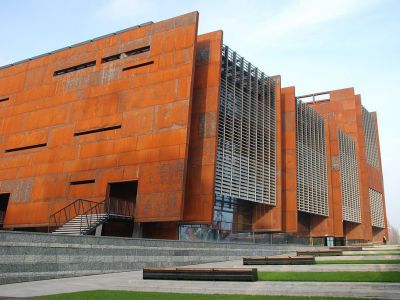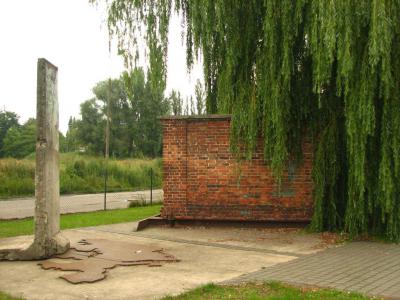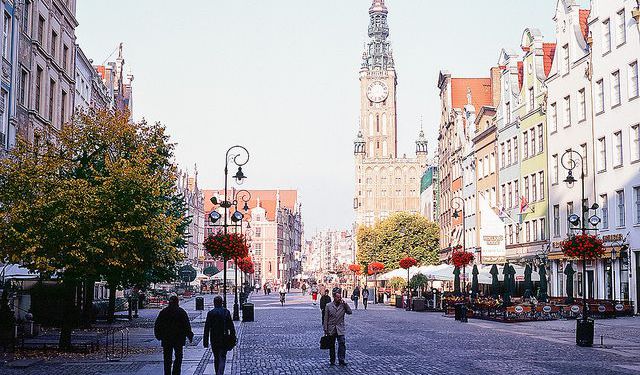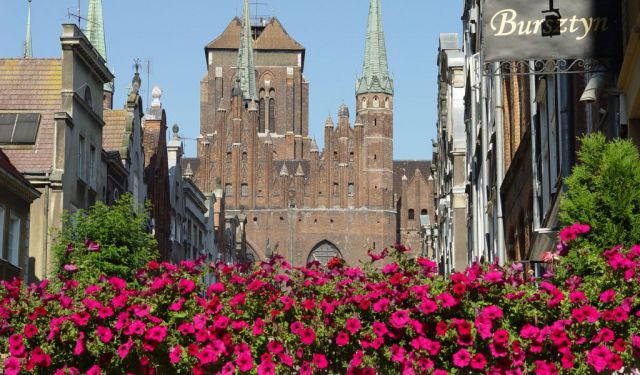Solidarity Union Walking Tour (Self Guided), Gdansk
For decades, the word 'Solidarity' (Polish: Solidarność) has been synonymous with the city of Gdansk. The peaceful Solidarity revolution, started here in the August of 1980, marked the outset of the fall of communism not only in Poland but also throughout Eastern Europe.
Stemmed from the country's first free labor union born out of strikes at the Lenin Shipyard (now the Gdansk Shipyard), Solidarność bloomed into a nationwide social movement. Even though many other Polish cities also partook in the struggle against communist rule, Solidarity is still strongly associated with its cradle in Gdansk and its leader Lech Wałęsa. Here, Wałęsa, the future president of Poland, had worked as an electrician in the 1970s. After being sacked for opposing the regime, he had formed the Inter-Enterprise Strike Committee whose activities would ultimately contribute to bringing down the iron curtain across the entire continent.
For most guests of the city, a visit to the local shipyard and other Solidarity sights forms part of a popular shore excursion that combines well with their Gdansk city tour. The best place to start it is the European Solidarity Centre (aka Solidarity Museum) highlighting some of the complicated chapters of Polish history (from the end of WWII to the free elections of 1989), outlining reasons for the strikes, the Gdansk Agreement, the carnival of Solidarity and Martial Law.
Nearby you will find the Monument to the fallen Shipyard Workers, commemorating the victims of police brutality during the strikes in 1970. Also, you will see a fragment of the shipyard wall that Lech Wałęsa famously climbed during the strike in 1980.
If you are a history buff with a keen interest in post-war Europe, we invite you to take this self-guided walking tour for a chance to explore Solidarity cause and places in Gdansk.
Stemmed from the country's first free labor union born out of strikes at the Lenin Shipyard (now the Gdansk Shipyard), Solidarność bloomed into a nationwide social movement. Even though many other Polish cities also partook in the struggle against communist rule, Solidarity is still strongly associated with its cradle in Gdansk and its leader Lech Wałęsa. Here, Wałęsa, the future president of Poland, had worked as an electrician in the 1970s. After being sacked for opposing the regime, he had formed the Inter-Enterprise Strike Committee whose activities would ultimately contribute to bringing down the iron curtain across the entire continent.
For most guests of the city, a visit to the local shipyard and other Solidarity sights forms part of a popular shore excursion that combines well with their Gdansk city tour. The best place to start it is the European Solidarity Centre (aka Solidarity Museum) highlighting some of the complicated chapters of Polish history (from the end of WWII to the free elections of 1989), outlining reasons for the strikes, the Gdansk Agreement, the carnival of Solidarity and Martial Law.
Nearby you will find the Monument to the fallen Shipyard Workers, commemorating the victims of police brutality during the strikes in 1970. Also, you will see a fragment of the shipyard wall that Lech Wałęsa famously climbed during the strike in 1980.
If you are a history buff with a keen interest in post-war Europe, we invite you to take this self-guided walking tour for a chance to explore Solidarity cause and places in Gdansk.
How it works: Download the app "GPSmyCity: Walks in 1K+ Cities" from Apple App Store or Google Play Store to your mobile phone or tablet. The app turns your mobile device into a personal tour guide and its built-in GPS navigation functions guide you from one tour stop to next. The app works offline, so no data plan is needed when traveling abroad.
Solidarity Union Walking Tour Map
Guide Name: Solidarity Union Walking Tour
Guide Location: Poland » Gdansk (See other walking tours in Gdansk)
Guide Type: Self-guided Walking Tour (Sightseeing)
# of Attractions: 5
Tour Duration: 1 Hour(s)
Travel Distance: 0.8 Km or 0.5 Miles
Author: vickyc
Sight(s) Featured in This Guide:
Guide Location: Poland » Gdansk (See other walking tours in Gdansk)
Guide Type: Self-guided Walking Tour (Sightseeing)
# of Attractions: 5
Tour Duration: 1 Hour(s)
Travel Distance: 0.8 Km or 0.5 Miles
Author: vickyc
Sight(s) Featured in This Guide:
- European Solidarity Centre
- BHP Hall
- Stocznia Gdańska (Gdańsk Shipyard)
- Monument to the Fallen Shipyard Workers
- Lech Wałęsa's Wall
1) European Solidarity Centre
The European Solidarity Centre (known as Europejskie Centrum Solidarności in Polish) is a museum and library dedicated to the history of Solidarity, a Polish trade union and civil resistance movement, as well as other opposition movements in Communist Eastern Europe.
The center is located in a modern, industrial-style building constructed in the 21st century. It's worth noting that finding the entrance to the center may be a bit challenging since it lacks clear signage. Since its opening in 2014, it has quickly become a must-visit attraction in the city. The building's design is reminiscent of the ship hulls constructed at the Gdańsk Shipyard.
The official opening ceremony occurred on August 31, 2014, coinciding with the anniversary of the signing of the Gdańsk Agreement. Lech Wałęsa, one of the co-founders of Solidarity and a later President of Poland, attended the ceremony.
The center recognizes and honors foreigners who played a role in supporting the Polish opposition to Communism by awarding them Medals of Gratitude. Its permanent collection boasts approximately 2,000 exhibits, and the library holds around 100,000 books and documents. In addition to being a museum and library, the center also serves as a hub for research and academic activities, hosts educational programs, and provides space for conferences and temporary exhibitions.
The center is located in a modern, industrial-style building constructed in the 21st century. It's worth noting that finding the entrance to the center may be a bit challenging since it lacks clear signage. Since its opening in 2014, it has quickly become a must-visit attraction in the city. The building's design is reminiscent of the ship hulls constructed at the Gdańsk Shipyard.
The official opening ceremony occurred on August 31, 2014, coinciding with the anniversary of the signing of the Gdańsk Agreement. Lech Wałęsa, one of the co-founders of Solidarity and a later President of Poland, attended the ceremony.
The center recognizes and honors foreigners who played a role in supporting the Polish opposition to Communism by awarding them Medals of Gratitude. Its permanent collection boasts approximately 2,000 exhibits, and the library holds around 100,000 books and documents. In addition to being a museum and library, the center also serves as a hub for research and academic activities, hosts educational programs, and provides space for conferences and temporary exhibitions.
2) BHP Hall
BHP Hall, also known as BHP Hall, holds a significant place in history as the location where the pivotal Gdańsk (also known as August) Agreements were reached on August 31, 1980. These agreements laid the foundation for the emergence of the independent and self-governing Solidarity (Solidarność) movement in Poland.
This imposing structure was constructed at the beginning of the 20th century as part of what was then called the Imperial Shipyard of Danzig (Kaiserliche Werft Danzig). It was completed in 1902 and consists of a two-story administrative section and a ground-level storage area. Today, the historic Great Hall is located within the storage area.
Originally, the facility served the military purposes of Prussia and later the Third Reich, primarily as a storage and assembly site for torpedoes used in warships. Due to its original function, it is also referred to as the Gdańsk Shipyard Torpedo Hall, and there is a historical inscription to that effect on the northeast facade.
Military production at this site came to an end in the spring of 1945. After a tragic fire incident on December 13, 1961, in which 22 workers lost their lives, the building was repurposed for occupational safety training and was subsequently named Sala BHP, which stands for Occupational Health and Safety (Bezpieczeństwo i higiena pracy). In 1979, a conference hall and a museum were established within its premises.
In 1999, in conjunction with Solidarity Square (Plac Solidarności), the building was officially designated as a historic monument. In December 2004, the Hall was taken over by the Independent Self-Governing Trade Union "Solidarity," and the current museum was established in 2010.
Inside the museum, visitors can find the carefully preserved presidium table, consisting of several smaller tables measuring 200 x 88 centimeters each. These tables were crafted in the carpentry shop of the Gdańsk Shipyard and were used during the meetings of the Inter-Enterprise Strike Committee. Additionally, there is an exhibition titled "Solidarity - Ways to the Agreement" on display.
This imposing structure was constructed at the beginning of the 20th century as part of what was then called the Imperial Shipyard of Danzig (Kaiserliche Werft Danzig). It was completed in 1902 and consists of a two-story administrative section and a ground-level storage area. Today, the historic Great Hall is located within the storage area.
Originally, the facility served the military purposes of Prussia and later the Third Reich, primarily as a storage and assembly site for torpedoes used in warships. Due to its original function, it is also referred to as the Gdańsk Shipyard Torpedo Hall, and there is a historical inscription to that effect on the northeast facade.
Military production at this site came to an end in the spring of 1945. After a tragic fire incident on December 13, 1961, in which 22 workers lost their lives, the building was repurposed for occupational safety training and was subsequently named Sala BHP, which stands for Occupational Health and Safety (Bezpieczeństwo i higiena pracy). In 1979, a conference hall and a museum were established within its premises.
In 1999, in conjunction with Solidarity Square (Plac Solidarności), the building was officially designated as a historic monument. In December 2004, the Hall was taken over by the Independent Self-Governing Trade Union "Solidarity," and the current museum was established in 2010.
Inside the museum, visitors can find the carefully preserved presidium table, consisting of several smaller tables measuring 200 x 88 centimeters each. These tables were crafted in the carpentry shop of the Gdańsk Shipyard and were used during the meetings of the Inter-Enterprise Strike Committee. Additionally, there is an exhibition titled "Solidarity - Ways to the Agreement" on display.
3) Stocznia Gdańska (Gdańsk Shipyard)
The Gdańsk Shipyard (Stocznia Gdańska) holds the distinction of being one of the largest shipyards globally. Its prominence reached a global scale in September 1980, as it became the epicenter for the birth of the Solidarity movement, or Solidarność in Polish. This marked the inception of organized opposition to Communist rule in Eastern Europe.
During that pivotal year, Gdańsk bore witness to a strike involving 17,000 shipbuilders, led by the shipyard electrician Lech Wałęsa. This labor action led to the official recognition of Solidarity as the first non-Communist trade union within the Soviet Bloc. This event represented one of the initial successful steps in a broader campaign of civil resistance that ultimately contributed to the eventual downfall of Communism across Eastern Europe.
The shipyard itself was established in 1946, occupying the site of former German shipyards, namely Schichau-Werft and Danziger Werft, both heavily damaged during World War II. During the era of the People's Republic of Poland, it was officially referred to as the Gdańsk Shipyard and Vladimir Lenin Shipyard in Gdańsk from 1967 to 1989. Additionally, in 1975, it was named "Westerplatte Heroes," in commemoration of The Battle of Westerplatte, which marked the beginning of World War II in Europe.
The shipyard's early launches occurred in 1948, involving the construction of fishing vessels such as smack and rescue boats for the Gdańsk Institute of Sea Fishing. Notably, it also produced the SS Sołdek, Poland's first seagoing vessel, which is now a museum ship. In 1949, the shipyard started making fishing lugo-trawlers. Then, from 1955, it focused on building troop landing craft, hydrographic ships, rescue vessels, training ships, and torpedo boats for navies like Poland, USSR, Bulgaria, Yugoslavia, and East Germany.
During that pivotal year, Gdańsk bore witness to a strike involving 17,000 shipbuilders, led by the shipyard electrician Lech Wałęsa. This labor action led to the official recognition of Solidarity as the first non-Communist trade union within the Soviet Bloc. This event represented one of the initial successful steps in a broader campaign of civil resistance that ultimately contributed to the eventual downfall of Communism across Eastern Europe.
The shipyard itself was established in 1946, occupying the site of former German shipyards, namely Schichau-Werft and Danziger Werft, both heavily damaged during World War II. During the era of the People's Republic of Poland, it was officially referred to as the Gdańsk Shipyard and Vladimir Lenin Shipyard in Gdańsk from 1967 to 1989. Additionally, in 1975, it was named "Westerplatte Heroes," in commemoration of The Battle of Westerplatte, which marked the beginning of World War II in Europe.
The shipyard's early launches occurred in 1948, involving the construction of fishing vessels such as smack and rescue boats for the Gdańsk Institute of Sea Fishing. Notably, it also produced the SS Sołdek, Poland's first seagoing vessel, which is now a museum ship. In 1949, the shipyard started making fishing lugo-trawlers. Then, from 1955, it focused on building troop landing craft, hydrographic ships, rescue vessels, training ships, and torpedo boats for navies like Poland, USSR, Bulgaria, Yugoslavia, and East Germany.
4) Monument to the Fallen Shipyard Workers
In Gdansk, the main feature of Solidarity Square is the towering 42-meter-tall Monument to the Fallen Shipyard Workers of 1970. This monument is a tribute to the 42 or more individuals who lost their lives during the December 1970 disturbances in the Coastal Cities. These protests were triggered by sudden increases in the prices of food and other basic goods and were harshly suppressed by the Polish People's Army and the Citizen's Militia, leading to over 40 deaths and more than 1,000 injuries.
Unveiled on December 16, 1980, near the entrance to the then Lenin Shipyard in Gdańsk, the Monument was established following the Gdańsk Agreement. It holds the distinction of being the first memorial for victims of communist rule built in a communist nation, a feat made possible only after the Agreement was signed. Financial support for its construction came from the striking workers, residents, and contributors from across Poland.
The government tried to delay and rename the monument to honor fallen policemen, but faced resistance. The Monument Committee overcame obstacles and unveiled it on the tenth anniversary of the 1970 events with a piece by Polish composer and conductor Krzysztof Penderecki commissioned by Lech Wałęsa.
The monument features three crosses, each 42 meters tall and weighing 36 tons, with a two-ton anchor hanging from each. At its base, some reliefs depict the lives of shipyard workers. It also includes a quote from Psalm 29 and a part of Czesław Miłosz's poem "Who You Wronged."
Unveiled on December 16, 1980, near the entrance to the then Lenin Shipyard in Gdańsk, the Monument was established following the Gdańsk Agreement. It holds the distinction of being the first memorial for victims of communist rule built in a communist nation, a feat made possible only after the Agreement was signed. Financial support for its construction came from the striking workers, residents, and contributors from across Poland.
The government tried to delay and rename the monument to honor fallen policemen, but faced resistance. The Monument Committee overcame obstacles and unveiled it on the tenth anniversary of the 1970 events with a piece by Polish composer and conductor Krzysztof Penderecki commissioned by Lech Wałęsa.
The monument features three crosses, each 42 meters tall and weighing 36 tons, with a two-ton anchor hanging from each. At its base, some reliefs depict the lives of shipyard workers. It also includes a quote from Psalm 29 and a part of Czesław Miłosz's poem "Who You Wronged."
5) Lech Wałęsa's Wall
By 1980 the Polish economy had been in severe crisis for five years. When the government drastically increased food prices again, the public mood in the country started boiling over with resentment about the poor living and working conditions.
Growing tensions resulted in eruption in the early hours of 14 August 1980 when Anna Walentynowicz, a 51-year-old crane driver at the Lenin Shipyard in Gdansk, was fired for her political stance. In a swift response to what they saw as unjust, the other shipyard workers went out on strike demanding both her reinstatement and pay rise.
The man who led the opposition movement was Lech Wałęsa, a former electrician at the shipyard who had previously been sacked by management, too, and for the same reason.
Towards 11 o’clock in the morning that same day, amid the events threatening to jeopardize planned protests and to endanger his activist colleagues, Wałęsa, locked outside the shipyard, climbed over the wall in order to assume leadership of the strike and to prevent further escalation.
This scaling of the wall became legendary and turned it into a symbol of the idea of freedom in Poland. The section of wall on Robotnicza Street over which Wałęsa had climbed into the closed shipyard was cut out and placed on display next to a section of the Berlin Wall between the shipyards and railway station, where it proudly stood until being destroyed by a car crashing into it. Currently rebuilt, the wall fragment stands outside of the Solidarity headquarters, a short walk from the shipyard gates.
Growing tensions resulted in eruption in the early hours of 14 August 1980 when Anna Walentynowicz, a 51-year-old crane driver at the Lenin Shipyard in Gdansk, was fired for her political stance. In a swift response to what they saw as unjust, the other shipyard workers went out on strike demanding both her reinstatement and pay rise.
The man who led the opposition movement was Lech Wałęsa, a former electrician at the shipyard who had previously been sacked by management, too, and for the same reason.
Towards 11 o’clock in the morning that same day, amid the events threatening to jeopardize planned protests and to endanger his activist colleagues, Wałęsa, locked outside the shipyard, climbed over the wall in order to assume leadership of the strike and to prevent further escalation.
This scaling of the wall became legendary and turned it into a symbol of the idea of freedom in Poland. The section of wall on Robotnicza Street over which Wałęsa had climbed into the closed shipyard was cut out and placed on display next to a section of the Berlin Wall between the shipyards and railway station, where it proudly stood until being destroyed by a car crashing into it. Currently rebuilt, the wall fragment stands outside of the Solidarity headquarters, a short walk from the shipyard gates.
Walking Tours in Gdansk, Poland
Create Your Own Walk in Gdansk
Creating your own self-guided walk in Gdansk is easy and fun. Choose the city attractions that you want to see and a walk route map will be created just for you. You can even set your hotel as the start point of the walk.
Gdansk Introduction Walking Tour
The most probable source for the name, "Gdansk" seems to be "Gdania", the ancient name of the river Motlawa. Gdansk began with agriculture and fishing and trade with Pomerania in the 9th century. It was annexed by Mieszko, Duke of Poland, in 975.
The center of town was the Long Market, with its craftsmen. German merchant settlements grew by St Nicholas Church. Gdansk joined... view more
Tour Duration: 2 Hour(s)
Travel Distance: 2.2 Km or 1.4 Miles
The center of town was the Long Market, with its craftsmen. German merchant settlements grew by St Nicholas Church. Gdansk joined... view more
Tour Duration: 2 Hour(s)
Travel Distance: 2.2 Km or 1.4 Miles
Gdansk's Historical Churches Tour
Gdansk has a long history of Catholicism, hence the abundance of spectacular churches here. Let's delve into some of the most impressive temples that grace the cityscape and see what they are.
Saint John's Church, a Gothic masterpiece, stands tall in the heart of Gdansk. It dates back to the 14th century and features impressive brickwork and intricate details. Its towering spire is a... view more
Tour Duration: 1 Hour(s)
Travel Distance: 1.6 Km or 1 Miles
Saint John's Church, a Gothic masterpiece, stands tall in the heart of Gdansk. It dates back to the 14th century and features impressive brickwork and intricate details. Its towering spire is a... view more
Tour Duration: 1 Hour(s)
Travel Distance: 1.6 Km or 1 Miles
The Most Popular Cities
/ view all










